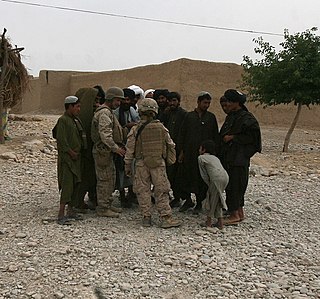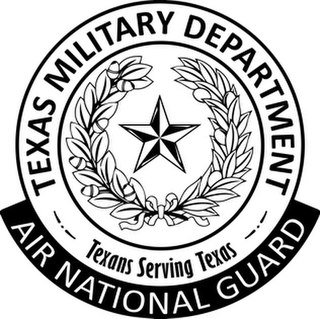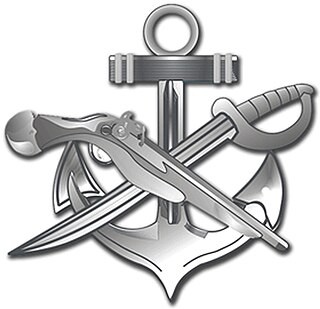Related Research Articles
A communications system or communication system is a collection of individual telecommunications networks, transmission systems, relay stations, tributary stations, and terminal equipment usually capable of interconnection and interoperation to form an integrated whole. The components of a communications system serve a common purpose, are technically compatible, use common procedures, respond to controls, and operate in union.
In telecommunication, the term long-haul communications has the following meanings:

MIL-STD-188 is a series of U.S. military standards relating to telecommunications.

The Joint Tactical Information Distribution System (JTIDS) is an L band Distributed Time Division Multiple Access (DTDMA) network radio system used by the United States armed forces and their allies to support data communications needs, principally in the air and missile defense community. It produces a spread spectrum signal using Frequency-shift keying (FSK) and Phase-shift keying (PSK) to spread the radiated power over a wider spectrum than normal radio transmissions. This reduces susceptibility to noise, jamming, and interception. In JTIDS Time Division Multiple Access (TDMA), each time interval is divided into time slots. Together, all 1536 time slots in a 12-second interval are called a "frame". Each time slot is "bursted" (transmitted) at several different carrier frequencies sequentially. Within each slot, the phase angle of the transmission burst is varied to provide PSK. Each type of data to be transmitted is assigned a slot or block of slots (channel) to manage information exchanges among user participation groups. In traditional TDMA, the slot frequencies remain fixed from second to second. In JTIDS TDMA, the slot frequencies and/or slot assignments for each channel do not remain fixed from frame to frame but are varied in a pseudo-random manner. The slot assignments, frequencies, and information are all encrypted to provide computer-to-computer connectivity in support of every type of military platform to include Air Force fighters and Navy submarines.

Military intelligence is a military discipline that uses information collection and analysis approaches to provide guidance and direction to assist commanders in their decisions. This aim is achieved by providing an assessment of data from a range of sources, directed towards the commanders' mission requirements or responding to questions as part of operational or campaign planning. To provide an analysis, the commander's information requirements are first identified, which are then incorporated into intelligence collection, analysis, and dissemination.

The Texas Air National Guard is the aerial militia of the State of Texas, United States of America. It is, along with the Texas Army National Guard, an element of the Texas National Guard. No element of the Texas Air National Guard is under United States Air Force command. They are under the jurisdiction of the Governor of Texas through the office of the Texas Adjutant General unless they are federalized by order of the President of the United States. The Texas Air National Guard is headquartered at Camp Mabry, Austin, and its commander is currently Major General John F. Nichols.

Milstar is a constellation of military communications satellites in geosynchronous orbit, which are operated by the United States Space Force, and provide secure and jam-resistant worldwide communications to meet the requirements of the Armed Forces of the United States. Six spacecraft were launched between 1994 and 2003, of which five are currently operational; the third launch failed, both damaging the satellite and leaving it in an unusable orbit.

United States Strategic Command (USSTRATCOM) is one of the eleven unified combatant commands in the United States Department of Defense. Headquartered at Offutt Air Force Base, Nebraska, USSTRATCOM is responsible for strategic deterrence, global strike, and operating the Defense Department's Global Information Grid. It also provides a host of capabilities to support the other combatant commands, including integrated missile defense; and global command, control, communications, computers, intelligence, surveillance, and reconnaissance (C4ISR). This command exists to give national leadership a unified resource for greater understanding of specific threats around the world and the means to respond to those threats rapidly.

The Tactical Air Control Party, commonly abbreviated TACP, is a small team of military personnel who provide coordination between aircraft and ground forces when providing close air support.

The Marine Corps Tactical Systems Support Activity (MCTSSA) is the Marine Air-Ground Task Force (MAGTF) Command, Control, Communication, Computer, Intelligence (C4I) Integration center for the United States Marine Corps. They are a component of Marine Corps Systems Command (MARCORSYSCOM) and are located at Marine Corps Base Camp Pendleton, California

The Special Warfare Combatant-craft Crewmen is a United States Naval Special Warfare Command team that operates and maintains small craft for special operations missions, particularly those in support of the U.S. Navy SEALs.

The United States Air Force's 281st Combat Communications Group was a Rhode Island Air National Guard combat communications unit located in North Smithfield, Rhode Island, United States.

The Project Manager Force Battle Command Brigade and Below is a component of the Program Executive Office Command Control and Communications Tactical Special Projects Office in the United States Army. The phrase "brigade and below" in the name refers to the fact that operations and communications within these smaller Army units are shifting to a digital integration.
The reconnaissance mission within the United States Marine Corps is divided into two distinct but complementary aspects; Marine Division Recon and Force Reconnaissance.

The United States Air Force's 251st Cyberspace Engineering Installation Group is an Air National Guard engineering installation unit located at Springfield ANGB, Ohio. It is the oldest communications/cyber group in the USAF and was originally chartered at the 251st Mobile Communications Group. The units assigned to the 251CEIG compromise 47.5% of the USAF's Engineering Installation capability and 47.5% of Department of Defenses Build and Extend Organic cyberspace infrastructure robust capability. The co-located 269th Combat Communications Squadron is also assigned to the 251st and is the USAF's Oldest Mobile Communications Squadrons rooted as the 1077th Signal Company Army Air Corps founded in March 1942. The Group Headquarters has 38 personnel assigned with a wartime mission to augment Major Command AFFOR staffs, Joint Force Commander staffs, Numbered Air Forces Warfighting Headquarters staffs or any Combatant Commanders cyber and Communications forward staff function.

Communications School is where selected United States Marine Corps commissioned and warrant officers are sent to learn the art and science of planning and employing communications and performing command and staff duties.

PM WIN-T is a component of Program Executive Office Command, Control and Communications-Tactical in the United States Army. PM WIN-T has been absorbed into PM Tactical Networks as Product Manager for Mission Networks.

The 224th Joint Communications Support Squadron, located in Brunswick, Georgia, provides deployable tactical communications for Joint Task Force (JTF) Headquarters and Joint Special Operations Task Force (JSOTF) Headquarters. It can operate in environments without a reliable terrestrial network. The squadron operationally reports to the Joint Communications Support Element of the Joint Enabling Capabilities Command—a direct reporting unit of U.S. Transportation Command—at MacDill Air Force Base, Florida.

The 202nd Engineering Installation Squadron is a unit of the Georgia Air National Guard. The installation, repair and serviceability of sophisticated command, control, communications, intelligence, intelligence, surveillance, and air reconnaissance to Air Force installations worldwide is the responsibility of the men and women of the 202nd Engineering Installation Squadron.

Counter-IED efforts are done primarily by military and law enforcement with the assistance of the diplomatic and financial communities. It involves a comprehensive approach of countering the threat networks that employ improvised explosive devices (IEDs), defeating the devices themselves, and training others. Counter-IED, or C-IED, is usually part of a broader counter-terrorism, counter-insurgency, or law enforcement effort. Because IEDs are a subset of a number of forms of asymmetric warfare used by insurgents and terrorists, C-IED activities are principally against adversaries and not only against IEDs. C-IED treats the IED as a systemic problem and aims to defeat the IED threat networks themselves.
References
 This article incorporates public domain material from the General Services Administration document: "Federal Standard 1037C".(in support of MIL-STD-188)
This article incorporates public domain material from the General Services Administration document: "Federal Standard 1037C".(in support of MIL-STD-188)